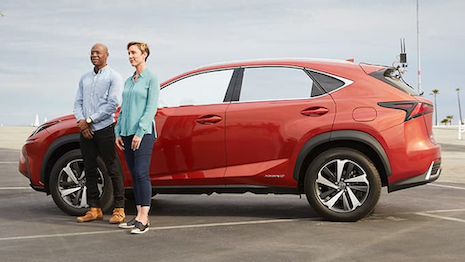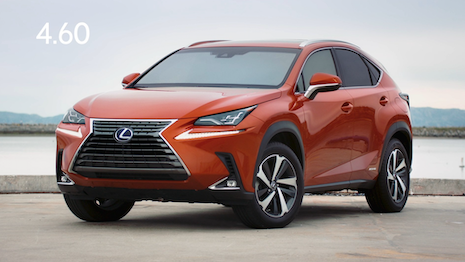 Test drivers with the Lexus NX 4.6 SUV. Image credit: Lexus
Test drivers with the Lexus NX 4.6 SUV. Image credit: Lexus
Toyota Corp.’s Lexus is aiming to shatter a misconception about texting and driving by bringing awareness to distracted driving with a new campaign.
According to the National Highway Safety Administration (NHTSA), the average length of time it takes to send or receive a text message while driving is 4.6 seconds. In honor of Distracted Driving Awareness Month, Lexus wants consumers to reflect on the choices they make while behind the wheel of their vehicles.
"Lexus is seeking to bring new meaning to the number 4.6 with 'Driving Disrupted,'" said Amanda Roark, product communications analyst at Lexus, Plano, TX. "The safety of our guests is of the utmost importance to us.
"So, for Distracted Driving Awareness Month, Lexus is aiming to change perceptions about texting and driving."
Driving Distracted
Established by the National Safety Council (NSC) more than a decade ago, April is National Distracted Driving Awareness Month.
Distracted driving claimed 3,142 lives in the United States in 2019, according to the most recent data available from NHTSA.
At 55 mph, if a driver takes their eyes off the road for 4.6 seconds, that is like driving the length of a football field with their eyes closed, making texting a significant factor in distracted driving related accidents.
The “Driving Disrupted” film campaign, released on April 6 or 4/6, demonstrates what happens when drivers can no longer see the road for 4.6 seconds.
Participants got behind the wheel of a Lexus NX on a closed course, under the assumption they were taking the Lexus NX SUV for a routine test drive.
What they did not know was that they were driving a specially modified Lexus NX 4.6 model, equipped with electrochromic technology that could instantaneously turn the windshield and windows from transparent to opaque.
While navigating the course, drivers’ views were completely and unexpectedly obscured for 4.6 seconds. The film captures drivers’ reactions and how, what seems like a quick distraction, completely affected their ability to drive.
Many veered off the course, hitting cones as well as styrofoam cutouts of bikers and pedestrians.
Moments after the destruction, one driver said, “That was the most terrifying experience.”
When Lexus revealed that the amount of time their views were obstructed was the same amount of time spent looking at a text message, one driver exclaimed, “I won’t be touching my phone — I’ll throw it in the glove compartment.”
 The Lexus NX 4.6 is not available for purchase. Image credit: Lexus
The Lexus NX 4.6 is not available for purchase. Image credit: Lexus
With this campaign, Lexus is trying to bring awareness to safety behind the wheel by changing perceptions about texting and driving, showing that even the most advanced safety systems on the road today cannot replace a driver’s undivided attention.
Safety first
Although Lexus’ point is that safety technology cannot replace the precision of a driver’s full attention, with electrification at the forefront of the automotive industry, many brands have developed new technology with drivers’ safety as the top priority.
German automaker Audi upgraded its car-to-X system to offer consumers real-time updates and warnings regarding slippery and challenging conditions. Audi’s car-to-X service “Local Hazard Information” (LHI) will now use a car-to-cloud application that can detect the tiniest changes in road surfaces, upload data to the cloud for processing and then warn upcoming drivers of road ice or disparate slippery driving conditions (see story).
Last year, British automaker Jaguar Land Rover developed “contactless touchscreen” technology in a bid to improve vehicle safety as well as fight bacteria in a rapidly changing world.
Developed with the help of the University of Cambridge, the patented “predictive touch” technology uses artificial intelligence and sensors to anticipate a driver’s intended movements on an infotainment system without touching. At the time, this was the automaker’s latest innovation as part of its Destination Zero vision (see story).